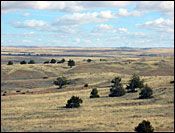Imagine a New Mexico with a healthy mosaic of native grasslands and woodlands amidst vast open prairies and mountainous regions. Landscapes with antelope, deer, elk and bighorn sheep. Running water in bosques of willows and cottonwoods, alive with the song of birds and the bloom of native wildflowers. 
Our landscapes are out of balance – what we see today is not the way things were, or should be in the future. Restoring landscapes is not just about aesthetics. It’s about economics, fish, wildlife, and people. And it’s the right thing to do.
|
This vision of New Mexico may no longer be the stuff of history books alone, thanks to a rapidly growing initiative involving the BLM, landowners, other agencies, conservation groups and industry partners.
“Restore New Mexico” aims to bring back hundreds of thousands of acres of the state’s native grasslands, woodlands and riparian areas to their pre-1900 ecological states. Since that time, human impacts from rapid population growth, transportation networks, oil and gas development and livestock grazing have taken their toll on the landscape. The BLM has worked with ranchers, landowners, conservation groups, the oil and gas industry, the New Mexico Association of Conservation Districts, county governments, and a variety of agencies (the State Land Office, the Game and Fish Department, and the Natural Resources Conservation Service) on the project since it was launched in 2005. Last year, the BLM and its partners restored and reclaimed 145,000 acres of public land, much of it in southeastern New Mexico. Over the next several years, we hope to restore and reclaim over a million acres of federal, state and private land. A core component of Restore New Mexico is to stem the growth of the invasive shrubs that have taken over the state’s grasslands in the past 150 years. Targeted species include mesquite, creosote, juniper, catclaw, tarbush and salt cedar, which today dominate much of the Land of Enchantment. Our landscapes are out of balance – what we see today is not the way things were, or should be in the future. Restoring landscapes is not just about aesthetics. It’s about economics, fish, wildlife, and people. And it’s the right thing to do. The BLM will tackle invasive plants with a combination of mechanical treatments, prescribed fires and chemical applications. Once invasive brush species have been treated, the use of prescribed fires can be returned to landscapes as a natural process to rejuvenate grasslands and woodlands. Treating salt cedar will allow cottonwoods, willows, and other native plants to once again flourish in the state’s streamside areas. 
“Restore New Mexico” aims to bring back hundreds of thousands of acres of the state’s native grasslands, woodlands and riparian areas to their pre-1900 ecological states. |
While many people have concerns about the use of herbicides, in many cases they are the only options available to treat today’s degraded landscapes. The good news is that modern herbicides are not persistent like DDT and other early chemicals; they break down rapidly after they are applied. They also treat targeted species while not being toxic to grasses, fish or wildlife. But bringing our grasslands and river systems back to their historic brilliance won’t be the only benefit of Restore New Mexico. Restoration projects will also improve local watersheds and aid local economies. For instance, reducing creosote will spur the growth of ground cover (grasses and forbs) in historic grasslands. Creosote, like mesquite and salt cedar, has extensive root systems that remove soil moisture needed by other plants. Some brush species also alter soil chemistry, making it extremely difficult for native grasses to return. Once landscapes are transformed into monocultures of brush, their value to fish, wildlife and people is greatly diminished. Healthy ground cover, however, slows rainfall, allowing water to percolate into subsurface aquifers, instead of merely running off. Restoring watersheds in turn provides more sustainable drinking water for local communities, irrigable water for farms, and water for fishing and other recreational uses. Restore New Mexico also aims to transform features of the landscape that are fragmenting grassland ecosystems – a big problem for wildlife that need large undisturbed areas to exist. In Eddy County, the BLM is identifying abandoned oil and gas field well pads and roads and removing the caliche (a material rich in clay that’s used to stabilize dirt roads) in those areas. Because caliche is sterile, native vegetation cannot grow on those sites. The BLM and its partners in the oil and gas industry are taking out this caliche and reseeding sites, as needed, with native plants. The caliche is then taken other areas to maintain or improve roads. We are working together to reclaim sites with the largest habitat areas. In other parts of the state, habitat for the antelope, Aplomado falcon and other species will be refurbished through companion efforts under Restore New Mexico. Ranchers who participate in the program must refrain from grazing treated areas until grasslands are restored. They will not be authorized to increase the sizes of their herds on public lands, but they will get “fatter calves faster.” Additional benefits will accrue to wildlife and watershed health. Improving the landscape provides economic benefits as well. By expanding the land that hunting and fishing can take place on, the BLM and its partners are aiding an industry that is already worth more than $330 million per year to New Mexico. Restore New Mexico is therefore about many things: restoring landscapes, restoring wildlife habitat, restoring watersheds and water supplies, and restoring the natural history of our great state. |